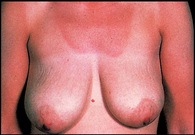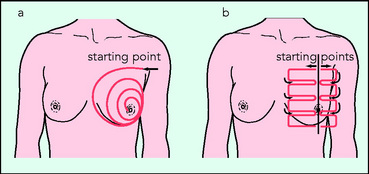Chapter 8 Female breasts and genitalia
SYMPTOMS OF BREAST DISEASE
Pain
The dynamic response of the tissue to changes in hormones may cause breast pain and tenderness which fluctuate predictably with the menstrual cycle. A painful breast in the first few months of lactation is almost always due to a bacterial infection of the gland and is characterised by fever, redness and tenderness over the infected segment.
EXAMINATION OF THE BREAST
Inspection
The patient should undress to the waist. Position yourself in front of the patient, who should be sitting comfortably with her arms at her side (Fig. 8.1). Ask the patient to raise her arms above her head and then press her hands against her hips. These movements tighten the suspensory ligaments, exaggerating the contours and highlighting any abnormality.
Breast palpation
Examine each breast by following a concentric or parallel trail that creates a systematic path that always begins and ends at a constant spot (Fig. 8.2). A comparison of the two breasts may help you to judge whether an area is abnormal or not.
Lymph node palpation
When examining the left axilla in the sitting position, the patient may rest her left hand on your right shoulder while you explore the axilla with your right hand. Abduct the arm gently by supporting the patient’s wrist with your right hand and examining with the other hand. Feel for the anterior group of nodes along the posterior border of the anterior axillary fold, the central group against the lateral chest wall and the posterior group along the posterior axillary fold. Finally, palpate along the medial border of the humerus to check for the lateral group of nodes. If you feel nodes, assess the size, shape, consistency, mobility and tenderness.
SYMPTOMS OF GENITAL TRACT DISEASE
Menstrual history
ESTABLISH THE AGE OF THE MENARCHE
Most European and North American girls start menstruating by the age of 14.5 years (range 9–16 years). Menarche occurs at an average weight of 48 kg. By the age of 14 years, secondary sexual characteristics should have appeared. If the menarche has not occurred and there are no other signs of sexual development, it is reasonable to consider organic causes of primary amenorrhoea, such as gonadal dysgenesis (Turner’s syndrome), congenital anatomical abnormalities of the genital tract (e.g. absence, uterine hypoplasia, vaginal hypoplasia), polycystic ovaries or pituitary or hypothalamic tumours in childhood. If secondary sexual characteristics have appeared, reassure the patient that investigation is usually only necessary if the menarche has not occurred by the age of 16 years.

 Differential diagnosis: Breast lumps
Differential diagnosis: Breast lumps
 Symptoms and signs: Breast examination
Symptoms and signs: Breast examination
 Questions to ask: The menstrual cycle
Questions to ask: The menstrual cycle Differential diagnosis: Secondary amenorrhoea
Differential diagnosis: Secondary amenorrhoea

